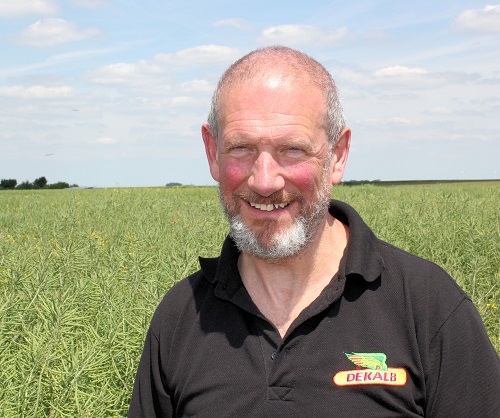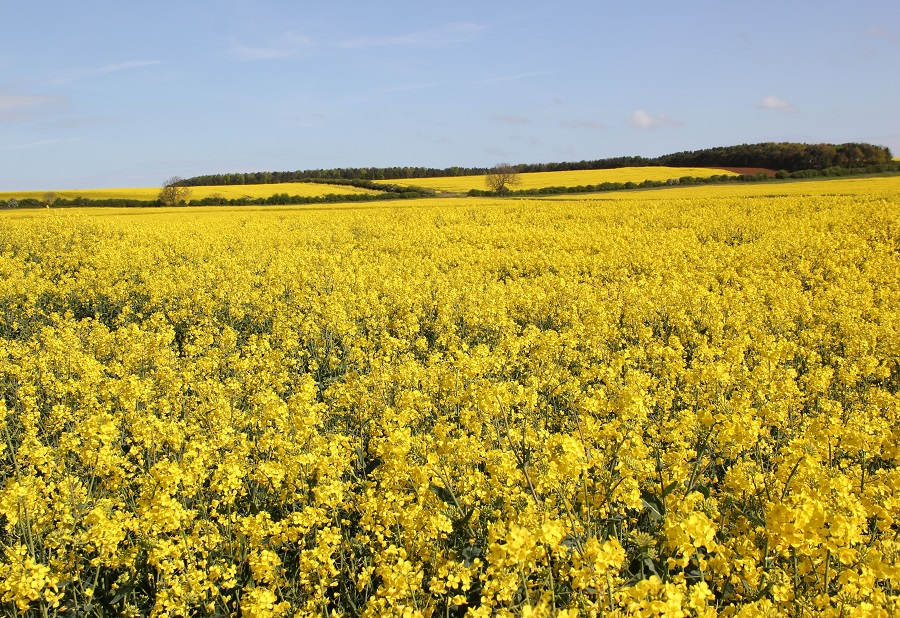As oilseed rape continues to fight for its place in the rotation, improved genetics may encourage growers to be more confident in how it could perform. CPM reviews Dekalb’s latest TuYV resistant variety, DK Excited.
Growers want to buy assurance.
By Charlotte Cunningham
AHDB’s Recommended List has been the long-standing ‘go-to’ for cereals and oilseed rape growers.
However, a variety’s recognition on the list and its performance in the field are not always mutually exclusive.

Matthew Clarke says that Excited is the next step up in Dekalb’s OSR breeding programme.
In fact, in the OSR market, some of the best-selling varieties have never appeared on the RL, and hoping to follow suit is the latest offering from the Dekalb stable, DK Excited – one of two new hybrids with turnip yellows virus (TuYV) resistance.
“The decision to enter a variety into the RL has to be made at quite an early stage. The reality is that we’ve got a broad European portfolio of varieties and not all can be entered into every national trial set at the same time,” explains breeder, Matthew Clarke. “By the time we realised how good DK Excited was for the UK, it was a little too late.
“However, this shouldn’t deter growers and there have been many excellent varieties grown here that haven’t gone through the UK system – DK Extrovert is a great example of this.”
Matthew says that Excited – along with fellow stable mate DK Expectation – is the next step up in Dekalb’s OSR breeding programme. “When we’re designing a new variety, we start by thinking about new parental lines and how, or where, they could fit as part of a final hybrid. But essentially, it’s all about considering what we can bring in to progress things.
“For us, it’s not necessarily about making huge, short-lived changes, but more about incremental improvements to existing varieties, aimed at characteristics like yield and oil content.”
To name-drop a few standout features, DK Excited boasts TuYV resistance – as well as double phoma and pod shatter resistance – wrapped in a package that delivers rapid vigour in the autumn and good oil content at harvest.
However, from a breeding perspective, it’s Excited’s all-round robustness that has impressed Matthew the most. “Looking at both our breeding trials and commercial data, DK Excited has proven to be incredibly robust across a wide range of environments. If we compare this to something like newly-recommended Expectation, which is has done well in UK trials, DK Excited does the same but over a much wider geography – meaning it’s likely to be an option for a bigger range of growers.
“This was actually something we picked out early in its development and it’s continually proven its ability to deliver consistent performance in a range of locations since.”
Looking to its TuYV resistance, Matthew reckons there’s a real demand in the market for varieties that boast this trait. “It seems to be what the market wants, so as breeders, it’s important that we can deliver that within our varieties. It’s also worth noting that resistant types have also benefited from higher yields. So while TuYV isn’t completely disastrous, having that inherent resistance could be another way of squeezing out those extra yield percentages.”
Bayer campaign manager, Lizzie Carr-Archer, agrees and says there has been a shift in TuYV resistance importance. “We have always said that traits like TuYV shouldn’t come at the expense of other things like light leaf spot, as we know that is a major yield robber.
“However, what we’ve tried to achieve with DK Excited is a good all-round package – as well as TuYV resistance. When you can stack TuYV on top of all of those other good traits, then you’re only bolstering that overall disease package.”
Double phoma and pod shatter resistance have become standard components in Dekalb varieties and Matthew credits this to their success so far. “Particularly with pod shatter, I think a lot of growers have realised what an advantage this trait can bring. Not only in terms of yield protection, but also for protecting future crops. We’ve seen a lot of cases where OSR volunteers have had an impact on future wheat crops, for example.”
As the long-term future of OSR continues to hang in the balance due to its continued issues with cabbage stem flea beetle, the rapid vigour of DK Excited could help to give growers the upper hand in the battle against the beetle. “A major part of the CSFB strategy now is getting a crop up and away quickly in the autumn and continuing that vigour in the spring. Having vigorous, robust varieties will undoubtedly play an important role in this respect.”
Another neat feature of the variety is its performance in the early drilling window, which could open up its suitability to a wide range of growers, reckons Lizzie. “In the past, hybrids have traditionally been drilled later. However, DK Excited is stiff strawed and actually suits an earlier position – doing well when drilled anywhere between 1 Aug -1 Sept. This, combined with its vigour, could be really useful for a range of growers and situations across the country.”
From the seed trade perspective, ADM Agriculture’s James Barlow claims Excited is a ‘do anything’ variety. “From what we’ve seen, you can drill it early or late, it has good vigour, phoma and light leaf spot resistance and of course, TuYV resistance. As well as this, the pod shatter protection makes it a really attractive choice – it seems like you can just put it anywhere and it will do well.”
James echoes the view that the vigour of the variety could help growers stand the best chance against CSFB damage. “DK Excited really demonstrates exactly what hybrid vigour is and the regrowth in the spring is also really good. What’s more, Dekalb’s establishment assurance scheme is one of the best in the business – in my opinion – which provides a huge safety net for growers sitting on the fence over whether or not they should continue to grow OSR. Ultimately, growers want to buy assurance.
“The only problem with this, is that labelling a variety as ‘vigorous’ has just become a standard part of branding and marketing, but from what we’ve seen in trials, DK Excited really is at the top end of growth.”
With no official RL data to compare against other varieties, potential growers have to use breeder’s data as a guide to DK Excited’s potential performance. While this is not strictly comparable with sources like the RL, it does give a good indication of how it’s likely to perform, says James. “In the case of Excited, if we were to extrapolate the data and cross reference it against other varieties on the RL, we think this variety would certainly be in the top half of the table.”
Though Excited’s yield is good, James reckons that for many OSR growers this is no longer a key priority when it comes to variety selection. “At the moment, just getting a crop of OSR to grow is a priority, let alone achieving high yields. So for me, the key things I’m looking for – in order of importance – are vigour, specific traits like TuYV, and then yield.
“It’s important to approach growing OSR with the right mindset. If you choose a variety that provides reliability across the whole package then you’re going to have the best chance of getting a crop to harvest.”
Openfield’s Duncan Durno also believes DK Excited is likely to be a popular option with growers. There has been a good string of varieties from Dekalb over the past few years known for their rapid establishment, early growth habit and vigour. DK Excited is an extension of this, but with the added benefit of TuYV resistance – protecting the variety’s inherent yield potential.”
He adds that TuYV is a ‘must-have’ for varieties now. “TuYV is a real issue and the level of crops infected is something that ought to be emphasised more. If we look at what’s happened in sugar beet with peach potato aphid (virus yellows) for example, TuYV is just as difficult to control for OSR growers.”
With minimal issues from CSFB, OSR is an important break crop for Staffs grower, Rob Atkin. “We have 397ha of arable ground and about 52.6ha of this goes to OSR – for us, it’s been a really good break crop and we haven’t had too many problems with CSFB damage, though we know it will move into the area more.”
But when it comes to selecting varieties, it’s a different kind of pest that the farm look to protect themselves from. “We’re on an estate where a lot of shooting is done, so our biggest threats are actually pheasants and partridges. Therefore, when picking out a variety, we’re looking for something that can be drilled early and get up and away quickly to minimise the crop damage risk.”
This year, Rob is trialling 21ha of Excited as a result of his former variety starting to drop off slightly yield-wise. “We picked out Excited largely for its vigour and performance out of the autumn, which ticked the big boxes for me straight away. For us, we’d rather a crop was looking slightly forward in Sept/Oct to ensure it doesn’t get hammered by pheasants.”
Rob drilled the Excited on 22 Aug, at 40 seeds/m2, and says it’s looking really well so far. “It’s just starting to flower but it looks really well. It came out of the winter strong – in fact, we were a little worried we’d have to slow it down,” he laughs.
“It started well again in the spring and was quick to get up and going and actually was one of the first field to flower.”
With a strong inherent disease profile, DK Excited is also showing ‘massive potential’ for organic OSR production, yielding 0.5t/ha more than one of the top UK Recommended TuYV-resistant hybrids in field-scale Scottish farm trial work overseen by independent agronomist, Andy Cheetham.
As well as TuYV and pod shatter resistance which Andy considers essential for organic regimes, DK Excited proved markedly more resistant to LLS in practice than the leading RL hybrid grown alongside it, he says.
Add its double phoma resistance and rapid autumn development – especially important in dealing with weeds – and he believes the all-round strength of the variety makes it especially well-suited to organic production.
“As we learn more about growing OSR organically and fine-tune our agronomy to make the most of it, I’m convinced we can get very much more out of DK Excited, in particular,” he stresses. “It was much bigger-stemmed, more robust, and better branched and podded than its RL rival. It has massive potential.”
OSR assurance
For those who want to take a punt on DK Excited, but are nervous about the prospect of a failed crop, once again this year Dekalb are running its popular Establishment Scheme – which is geared up to support the growing of hybrids including Excited. “The scheme means that if a grower drills DK Excited prior to 20 Sept and the field fails to establish before the end of Oct, then they are entitled to a credit of £100/bag,” explains Lizzie. “We know there is a lot of nervousness around growing OSR, so including DK Excited within the scheme this year is our way of putting a stamp of quality and trust on the variety.
“Our goal is to provide farmers with robust genetics that they can be confident in.”
DK Excited at a glance





